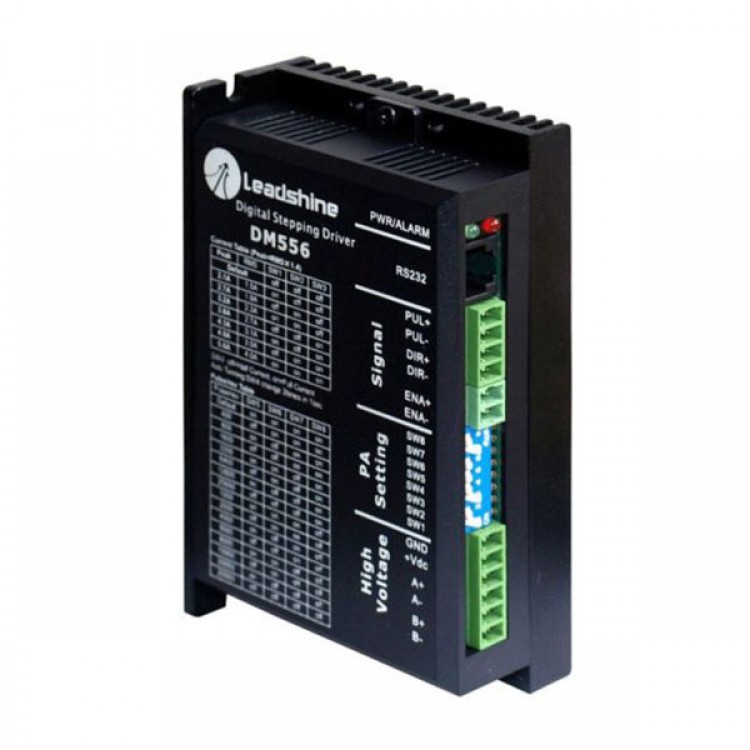
| Quantity | 3+ units | 10+ units | 30+ units | 50+ units | More |
|---|---|---|---|---|---|
| Price /Unit | $67.13 | $65.76 | $63.71 | $60.97 | Contact US |
 H2MD DC24-120V 6A Engraving Machine CNC Stepper Motor Driver Module Support Phase Dislocation Protection
$45.54
H2MD DC24-120V 6A Engraving Machine CNC Stepper Motor Driver Module Support Phase Dislocation Protection
$45.54
 ZM-3H2080 24V High Performance 3-Phase Stepper Motor Driver Controller AC80-220V for 86-130MM Stepper Motors
$166.32
ZM-3H2080 24V High Performance 3-Phase Stepper Motor Driver Controller AC80-220V for 86-130MM Stepper Motors
$166.32
 ZM-3H2080 12V High Performance 3-Phase Stepper Motor Driver Controller AC80-220V for 86-130MM Stepper Motors
$166.32
ZM-3H2080 12V High Performance 3-Phase Stepper Motor Driver Controller AC80-220V for 86-130MM Stepper Motors
$166.32
Leadshine DM556 2-Phase Digital Stepper Drive Driver 20 to 50 VDC/0.5 and 5.6A
|
Parameters |
DM556 |
|||
|
Min |
Typical |
Max |
Unit |
|
|
Output current |
0.5 |
- |
5.6 (4.0 RMS) |
A |
|
Supply voltage |
+20 |
- |
+50 |
VDC |
|
Logic signal current |
7 |
10 |
16 |
mA |
|
Pulse input frequency |
0 |
- |
200 |
kHz |
|
Isolation resistance |
500 |
|
|
Mohm |
Connector P1 Configurations
|
Pin Function |
Details |
|
PUL+ |
Pulse signal: In single pulse (pulse/direction) mode, this input represents pulse signal, each rising or falling edge active (software configurable); 4-5V when PUL-HIGH, 0-0.5V when PUL-LOW. In double pulse mode (pulse/pulse) , this input represents clockwise (CW) pulse,active both at high level and low level (software configurable). For reliable response, pulse width should be longer than 2.5µs. Series connect resistors for current-limiting when +12V or +24V used. The same as DIR and ENA signals. |
|
PUL- |
|
|
DIR+ |
DIR signal: In single-pulse mode, this signal has low/high voltage levels, representing two directions of motor rotation; in double-pulse mode (software configurable), this signal is counter-clock (CCW) pulse,active both at high level and low level (software configurable). For reliable motion response, DIR signal should be ahead of PUL signal by 5µs at least. 4-5V when DIR-HIGH, 0-0.5V when DIR-LOW. Please note that rotation direction is also related to motor-drive wiring match. Exchanging the connection of two wires for a coil to the drive will reverse motion direction. |
|
DIR- |
|
|
ENA+ |
Enable signal: This signal is used for enabling/disabling the drive. High level (NPN control signal, PNP and Differential control signals are on the contrary, namely Low level for enabling.) for enabling the drive and low level for disabling the drive. Usually left UNCONNECTED (ENABLED). |
|
ENA- |
Connector P2 Configurations
|
Pin Function |
Details |
|
+Vdc |
Power supply, 20~50 VDC, Including voltage fluctuation and EMF voltage. |
|
GND |
Power Ground. |
|
A+, A- |
Motor Phase A |
|
B+, B- |
Motor Phase B |
Microstep resolutions and output current are programmable, the former can be set from full-step to 102,400 steps/rev and the latter can be set from 0.5A to 5.6A.
However, when it's not in software configured mode, this drive uses an 8-bit DIP switch to set microstep resolution, and motor operating current, as shown below:

Microstep Resolution Selection
When it's not in software configured mode, microstep resolution is set by SW5, 6, 7, 8 of the DIP switch as shown in the following table:
|
Microstep
|
Steps/rev.(for 1.8o motor) |
SW5 |
SW6 |
SW7 |
SW8 |
|
1 to 512 |
Default/Software configured |
on |
on |
on |
on |
|
2 |
400 |
off |
on |
on |
on |
|
4 |
800 |
on |
off |
on |
on |
|
8 |
1600 |
off |
off |
on |
on |
|
16 |
3200 |
on |
on |
off |
on |
|
32 |
6400 |
off |
on |
off |
on |
|
64 |
12800 |
on |
off |
off |
on |
|
128 |
25600 |
off |
off |
off |
on |
|
5 |
1000 |
on |
on |
on |
off |
|
10 |
2000 |
off |
on |
on |
off |
|
20 |
4000 |
on |
off |
on |
off |
|
25 |
5000 |
off |
off |
on |
off |
|
40 |
8000 |
on |
on |
off |
off |
|
50 |
10000 |
off |
on |
off |
off |
|
100 |
20000 |
on |
off |
off |
off |
|
125 |
25000 |
off |
off |
off |
off |
Current Settings
When it's not in software configured mode, the first three bits (SW1, 2, 3) of the DIP switch are used to set the dynamic current. Select a setting closest to your motor's required current.
|
Peak Current
|
RMS Current |
SW1 |
SW2 |
SW3 |
|
Default/Software configured (0.5 to 5.6A) |
OFF |
OFF |
OFF |
|
|
2.1A |
1.5A |
ON |
OFF |
OFF |
|
2.7A |
1.9A |
OFF |
ON |
OFF |
|
3.2A |
2.3A |
ON |
ON |
OFF |
|
3.8A |
2.7A |
OFF |
OFF |
ON |
|
4.3A |
3.1A |
ON |
OFF |
ON |
|
4.9A |
3.5A |
OFF |
ON |
ON |
|
5.6A |
4.0A |
ON |
ON |
ON |
Note: Due to motor inductance, the actual current in the coil may be smaller than the dynamic current setting, particularly under high speed condition.
